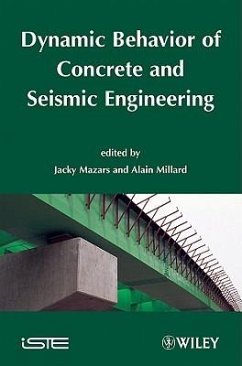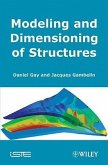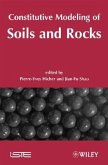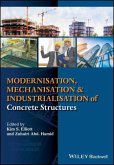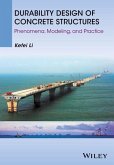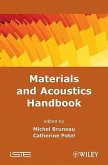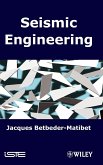Dynamic Behavior of Concrete and Seismic Engineering
Herausgeber: Mazars, Jacky; Millard, Alain
Dynamic Behavior of Concrete and Seismic Engineering
Herausgeber: Mazars, Jacky; Millard, Alain
- Gebundenes Buch
- Merkliste
- Auf die Merkliste
- Bewerten Bewerten
- Teilen
- Produkt teilen
- Produkterinnerung
- Produkterinnerung
While the static behavior of concrete has been the subject of numerous works, the same cannot be said for the dynamic behavior. This book sets out to remedy this situation: it begins by presenting the most frequently used experimental techniques in the study of the dynamic behavior of concrete, then continues by examining seismicity and seismic behavior, soil behavior, models of concrete structures subject to seismic activity, seismic calculation methods of structures, and paraseismic engineering.
Andere Kunden interessierten sich auch für
![Modeling and Dimensioning of Structures Modeling and Dimensioning of Structures]() Daniel GayModeling and Dimensioning of Structures312,99 €
Daniel GayModeling and Dimensioning of Structures312,99 €![Constitutive Modeling of Soils and Rocks Constitutive Modeling of Soils and Rocks]() Constitutive Modeling of Soils and Rocks290,99 €
Constitutive Modeling of Soils and Rocks290,99 €![Modernisation, Mechanisation and Industrialisation of Concrete Structures Modernisation, Mechanisation and Industrialisation of Concrete Structures]() Modernisation, Mechanisation and Industrialisation of Concrete Structures123,99 €
Modernisation, Mechanisation and Industrialisation of Concrete Structures123,99 €![Durability Design of Concrete Structures Durability Design of Concrete Structures]() Kefei LiDurability Design of Concrete Structures139,99 €
Kefei LiDurability Design of Concrete Structures139,99 €![Plant Equipment & Maintenance Engineering Handbook Plant Equipment & Maintenance Engineering Handbook]() Duncan RichardsonPlant Equipment & Maintenance Engineering Handbook181,99 €
Duncan RichardsonPlant Equipment & Maintenance Engineering Handbook181,99 €![Materials and Acoustics Handbook Materials and Acoustics Handbook]() Materials and Acoustics Handbook486,99 €
Materials and Acoustics Handbook486,99 €![Seismic Engineering Seismic Engineering]() Jacques Betbeder-MatibetSeismic Engineering435,99 €
Jacques Betbeder-MatibetSeismic Engineering435,99 €-
-
-
While the static behavior of concrete has been the subject of numerous works, the same cannot be said for the dynamic behavior. This book sets out to remedy this situation: it begins by presenting the most frequently used experimental techniques in the study of the dynamic behavior of concrete, then continues by examining seismicity and seismic behavior, soil behavior, models of concrete structures subject to seismic activity, seismic calculation methods of structures, and paraseismic engineering.
Produktdetails
- Produktdetails
- Verlag: Wiley
- Seitenzahl: 384
- Erscheinungstermin: 1. April 2009
- Englisch
- Abmessung: 234mm x 152mm x 28mm
- Gewicht: 703g
- ISBN-13: 9781848210714
- ISBN-10: 184821071X
- Artikelnr.: 25372277
- Herstellerkennzeichnung
- Libri GmbH
- Europaallee 1
- 36244 Bad Hersfeld
- gpsr@libri.de
- Verlag: Wiley
- Seitenzahl: 384
- Erscheinungstermin: 1. April 2009
- Englisch
- Abmessung: 234mm x 152mm x 28mm
- Gewicht: 703g
- ISBN-13: 9781848210714
- ISBN-10: 184821071X
- Artikelnr.: 25372277
- Herstellerkennzeichnung
- Libri GmbH
- Europaallee 1
- 36244 Bad Hersfeld
- gpsr@libri.de
Jacky Mazars is a Professor at the National Polytechnic Institute of Grenoble, France. He is an expert in mechanical behavior and durability of civil engineering structures.
Preface . xi
Chapter 1. Dynamic Behavior of Concrete: Experimental Aspects 1
François Toutlemonde and Gérard Gary
1.1. Introduction 1
1.2. Tests in which the transient rate has little influence 10
1.3. Tests with transient phase conditioned interpretations 20
1.4. Other tests 29
1.5. Synthesis of the experimental data on concrete and associated
materials 33
1.6. Conclusion 46
1.7. Bibliography 47
Chapter 2. Dynamic Behavior of Concrete: Constitutive Models 55
Patrice Bailly
2.1. Dynamics of concrete structures 55
2.2. Fast dynamics applied to concrete 62
2.3. Scabbing 68
2.4. Effect of a shock wave on the structure of materials 69
2.5. Modeling types 70
2.6. Models 76
2.7. Conclusion 90
2.8. Bibliography 92
Chapter 3. Seismic Ground Motion 95
Pierre-Yves Bard
3.1. Introduction 95
3.2. Measuring seismic motions 96
3.3. Quantitative characterization of seismic movements 98
3.4. Factors affecting seismic motions 108
3.5. Conclusions 120
3.6. Bibliography 121
Chapter 4. Soil Behavior: Dynamic Soil-Structure Interactions 125
Alain Pecker
Introduction 125
4.1. Behavior of soils under seismic loading 126
4.2. Modeling soil behavior 131
4.3. Linear soil-structure interactions 143
4.4. Non-linear soil-structure interactions 158
4.5. Bibliography 161
Chapter 5. Experimental Methods in Earthquake Engineering 165
Alain Millard, Pierre Pegon and Jean-Claude Queval
Introduction 165
5.1. The pseudo-dynamic method 167
5.2. The conventional pseudo-dynamic method 170
5.3. Continuous pseudo-dynamic method 178
5.4. Final comments 183
5.5. Shaking table tests 184
5.6. Laws of similarity 193
5.7. Instrumentation 194
5.8. Loading 195
5.9. Conclusion 196
5.10. Bibliography 197
Chapter 6. Experiments on Large Structures 201
Patrick Paultre and Jean Proulx
Introduction 201
6.1. Instrumentation 202
6.2. Dynamic loads 205
6.3. Data processing 206
6.4. Application to buildings 208
6.5. Bridge application 213
6.6. Application to large dams 220
6.7. Conclusion 230
6.8. Acknowledgements 230
6.9. Bibliography 230
Chapter 7. Models for Simulating the Seismic Response of Concrete
Structures 233
Didier Combescure, Nicolas Ile, Jacky Mazars and Jean-Marie Reynouard
7.1. Introduction 233
7.2. Different discretization families 234
7.3. Behavior laws for concrete 240
7.4. A few examples with their validation through experiments 250
7.5. Conclusions 269
7.6. Bibliography 270
Chapter 8. Seismic Analysis of Structures: Improvements Due to
Probabilistic Concepts 273
Jean-René Gibert
8.1. Introduction 273
8.2. The modal method 274
8.3. Criticism of the modal method 279
8.4. A few reminders about random processes 280
8.5. Improvements to the modal method 292
8.6. Direct calculation of the floor spectra 297
8.7. Creation of synthetic signals and direct numerical integration 301
8.8. Seismic analysis of non-linear behavior structures 304
8.9. Conclusion 323
8.10. Bibliography 323
Chapter 9. Engineering Know-How: Lessons from Earthquakes and Rules for
Seismic Design 327
Philippe Bisch
9.1. Introduction 327
9.2. Lessons from earthquakes 327
9.3. The aims of anti-seismic protection standards 336
9.4. General design 344
9.5. Behavior coefficients 349
9.6. Designing and dimensioning reinforced concrete structure elements 353
9.7. Conclusions 366
9.8. Bibliography 366
List of Authors 369
Index 373
Chapter 1. Dynamic Behavior of Concrete: Experimental Aspects 1
François Toutlemonde and Gérard Gary
1.1. Introduction 1
1.2. Tests in which the transient rate has little influence 10
1.3. Tests with transient phase conditioned interpretations 20
1.4. Other tests 29
1.5. Synthesis of the experimental data on concrete and associated
materials 33
1.6. Conclusion 46
1.7. Bibliography 47
Chapter 2. Dynamic Behavior of Concrete: Constitutive Models 55
Patrice Bailly
2.1. Dynamics of concrete structures 55
2.2. Fast dynamics applied to concrete 62
2.3. Scabbing 68
2.4. Effect of a shock wave on the structure of materials 69
2.5. Modeling types 70
2.6. Models 76
2.7. Conclusion 90
2.8. Bibliography 92
Chapter 3. Seismic Ground Motion 95
Pierre-Yves Bard
3.1. Introduction 95
3.2. Measuring seismic motions 96
3.3. Quantitative characterization of seismic movements 98
3.4. Factors affecting seismic motions 108
3.5. Conclusions 120
3.6. Bibliography 121
Chapter 4. Soil Behavior: Dynamic Soil-Structure Interactions 125
Alain Pecker
Introduction 125
4.1. Behavior of soils under seismic loading 126
4.2. Modeling soil behavior 131
4.3. Linear soil-structure interactions 143
4.4. Non-linear soil-structure interactions 158
4.5. Bibliography 161
Chapter 5. Experimental Methods in Earthquake Engineering 165
Alain Millard, Pierre Pegon and Jean-Claude Queval
Introduction 165
5.1. The pseudo-dynamic method 167
5.2. The conventional pseudo-dynamic method 170
5.3. Continuous pseudo-dynamic method 178
5.4. Final comments 183
5.5. Shaking table tests 184
5.6. Laws of similarity 193
5.7. Instrumentation 194
5.8. Loading 195
5.9. Conclusion 196
5.10. Bibliography 197
Chapter 6. Experiments on Large Structures 201
Patrick Paultre and Jean Proulx
Introduction 201
6.1. Instrumentation 202
6.2. Dynamic loads 205
6.3. Data processing 206
6.4. Application to buildings 208
6.5. Bridge application 213
6.6. Application to large dams 220
6.7. Conclusion 230
6.8. Acknowledgements 230
6.9. Bibliography 230
Chapter 7. Models for Simulating the Seismic Response of Concrete
Structures 233
Didier Combescure, Nicolas Ile, Jacky Mazars and Jean-Marie Reynouard
7.1. Introduction 233
7.2. Different discretization families 234
7.3. Behavior laws for concrete 240
7.4. A few examples with their validation through experiments 250
7.5. Conclusions 269
7.6. Bibliography 270
Chapter 8. Seismic Analysis of Structures: Improvements Due to
Probabilistic Concepts 273
Jean-René Gibert
8.1. Introduction 273
8.2. The modal method 274
8.3. Criticism of the modal method 279
8.4. A few reminders about random processes 280
8.5. Improvements to the modal method 292
8.6. Direct calculation of the floor spectra 297
8.7. Creation of synthetic signals and direct numerical integration 301
8.8. Seismic analysis of non-linear behavior structures 304
8.9. Conclusion 323
8.10. Bibliography 323
Chapter 9. Engineering Know-How: Lessons from Earthquakes and Rules for
Seismic Design 327
Philippe Bisch
9.1. Introduction 327
9.2. Lessons from earthquakes 327
9.3. The aims of anti-seismic protection standards 336
9.4. General design 344
9.5. Behavior coefficients 349
9.6. Designing and dimensioning reinforced concrete structure elements 353
9.7. Conclusions 366
9.8. Bibliography 366
List of Authors 369
Index 373
Preface . xi
Chapter 1. Dynamic Behavior of Concrete: Experimental Aspects 1
François Toutlemonde and Gérard Gary
1.1. Introduction 1
1.2. Tests in which the transient rate has little influence 10
1.3. Tests with transient phase conditioned interpretations 20
1.4. Other tests 29
1.5. Synthesis of the experimental data on concrete and associated
materials 33
1.6. Conclusion 46
1.7. Bibliography 47
Chapter 2. Dynamic Behavior of Concrete: Constitutive Models 55
Patrice Bailly
2.1. Dynamics of concrete structures 55
2.2. Fast dynamics applied to concrete 62
2.3. Scabbing 68
2.4. Effect of a shock wave on the structure of materials 69
2.5. Modeling types 70
2.6. Models 76
2.7. Conclusion 90
2.8. Bibliography 92
Chapter 3. Seismic Ground Motion 95
Pierre-Yves Bard
3.1. Introduction 95
3.2. Measuring seismic motions 96
3.3. Quantitative characterization of seismic movements 98
3.4. Factors affecting seismic motions 108
3.5. Conclusions 120
3.6. Bibliography 121
Chapter 4. Soil Behavior: Dynamic Soil-Structure Interactions 125
Alain Pecker
Introduction 125
4.1. Behavior of soils under seismic loading 126
4.2. Modeling soil behavior 131
4.3. Linear soil-structure interactions 143
4.4. Non-linear soil-structure interactions 158
4.5. Bibliography 161
Chapter 5. Experimental Methods in Earthquake Engineering 165
Alain Millard, Pierre Pegon and Jean-Claude Queval
Introduction 165
5.1. The pseudo-dynamic method 167
5.2. The conventional pseudo-dynamic method 170
5.3. Continuous pseudo-dynamic method 178
5.4. Final comments 183
5.5. Shaking table tests 184
5.6. Laws of similarity 193
5.7. Instrumentation 194
5.8. Loading 195
5.9. Conclusion 196
5.10. Bibliography 197
Chapter 6. Experiments on Large Structures 201
Patrick Paultre and Jean Proulx
Introduction 201
6.1. Instrumentation 202
6.2. Dynamic loads 205
6.3. Data processing 206
6.4. Application to buildings 208
6.5. Bridge application 213
6.6. Application to large dams 220
6.7. Conclusion 230
6.8. Acknowledgements 230
6.9. Bibliography 230
Chapter 7. Models for Simulating the Seismic Response of Concrete
Structures 233
Didier Combescure, Nicolas Ile, Jacky Mazars and Jean-Marie Reynouard
7.1. Introduction 233
7.2. Different discretization families 234
7.3. Behavior laws for concrete 240
7.4. A few examples with their validation through experiments 250
7.5. Conclusions 269
7.6. Bibliography 270
Chapter 8. Seismic Analysis of Structures: Improvements Due to
Probabilistic Concepts 273
Jean-René Gibert
8.1. Introduction 273
8.2. The modal method 274
8.3. Criticism of the modal method 279
8.4. A few reminders about random processes 280
8.5. Improvements to the modal method 292
8.6. Direct calculation of the floor spectra 297
8.7. Creation of synthetic signals and direct numerical integration 301
8.8. Seismic analysis of non-linear behavior structures 304
8.9. Conclusion 323
8.10. Bibliography 323
Chapter 9. Engineering Know-How: Lessons from Earthquakes and Rules for
Seismic Design 327
Philippe Bisch
9.1. Introduction 327
9.2. Lessons from earthquakes 327
9.3. The aims of anti-seismic protection standards 336
9.4. General design 344
9.5. Behavior coefficients 349
9.6. Designing and dimensioning reinforced concrete structure elements 353
9.7. Conclusions 366
9.8. Bibliography 366
List of Authors 369
Index 373
Chapter 1. Dynamic Behavior of Concrete: Experimental Aspects 1
François Toutlemonde and Gérard Gary
1.1. Introduction 1
1.2. Tests in which the transient rate has little influence 10
1.3. Tests with transient phase conditioned interpretations 20
1.4. Other tests 29
1.5. Synthesis of the experimental data on concrete and associated
materials 33
1.6. Conclusion 46
1.7. Bibliography 47
Chapter 2. Dynamic Behavior of Concrete: Constitutive Models 55
Patrice Bailly
2.1. Dynamics of concrete structures 55
2.2. Fast dynamics applied to concrete 62
2.3. Scabbing 68
2.4. Effect of a shock wave on the structure of materials 69
2.5. Modeling types 70
2.6. Models 76
2.7. Conclusion 90
2.8. Bibliography 92
Chapter 3. Seismic Ground Motion 95
Pierre-Yves Bard
3.1. Introduction 95
3.2. Measuring seismic motions 96
3.3. Quantitative characterization of seismic movements 98
3.4. Factors affecting seismic motions 108
3.5. Conclusions 120
3.6. Bibliography 121
Chapter 4. Soil Behavior: Dynamic Soil-Structure Interactions 125
Alain Pecker
Introduction 125
4.1. Behavior of soils under seismic loading 126
4.2. Modeling soil behavior 131
4.3. Linear soil-structure interactions 143
4.4. Non-linear soil-structure interactions 158
4.5. Bibliography 161
Chapter 5. Experimental Methods in Earthquake Engineering 165
Alain Millard, Pierre Pegon and Jean-Claude Queval
Introduction 165
5.1. The pseudo-dynamic method 167
5.2. The conventional pseudo-dynamic method 170
5.3. Continuous pseudo-dynamic method 178
5.4. Final comments 183
5.5. Shaking table tests 184
5.6. Laws of similarity 193
5.7. Instrumentation 194
5.8. Loading 195
5.9. Conclusion 196
5.10. Bibliography 197
Chapter 6. Experiments on Large Structures 201
Patrick Paultre and Jean Proulx
Introduction 201
6.1. Instrumentation 202
6.2. Dynamic loads 205
6.3. Data processing 206
6.4. Application to buildings 208
6.5. Bridge application 213
6.6. Application to large dams 220
6.7. Conclusion 230
6.8. Acknowledgements 230
6.9. Bibliography 230
Chapter 7. Models for Simulating the Seismic Response of Concrete
Structures 233
Didier Combescure, Nicolas Ile, Jacky Mazars and Jean-Marie Reynouard
7.1. Introduction 233
7.2. Different discretization families 234
7.3. Behavior laws for concrete 240
7.4. A few examples with their validation through experiments 250
7.5. Conclusions 269
7.6. Bibliography 270
Chapter 8. Seismic Analysis of Structures: Improvements Due to
Probabilistic Concepts 273
Jean-René Gibert
8.1. Introduction 273
8.2. The modal method 274
8.3. Criticism of the modal method 279
8.4. A few reminders about random processes 280
8.5. Improvements to the modal method 292
8.6. Direct calculation of the floor spectra 297
8.7. Creation of synthetic signals and direct numerical integration 301
8.8. Seismic analysis of non-linear behavior structures 304
8.9. Conclusion 323
8.10. Bibliography 323
Chapter 9. Engineering Know-How: Lessons from Earthquakes and Rules for
Seismic Design 327
Philippe Bisch
9.1. Introduction 327
9.2. Lessons from earthquakes 327
9.3. The aims of anti-seismic protection standards 336
9.4. General design 344
9.5. Behavior coefficients 349
9.6. Designing and dimensioning reinforced concrete structure elements 353
9.7. Conclusions 366
9.8. Bibliography 366
List of Authors 369
Index 373

